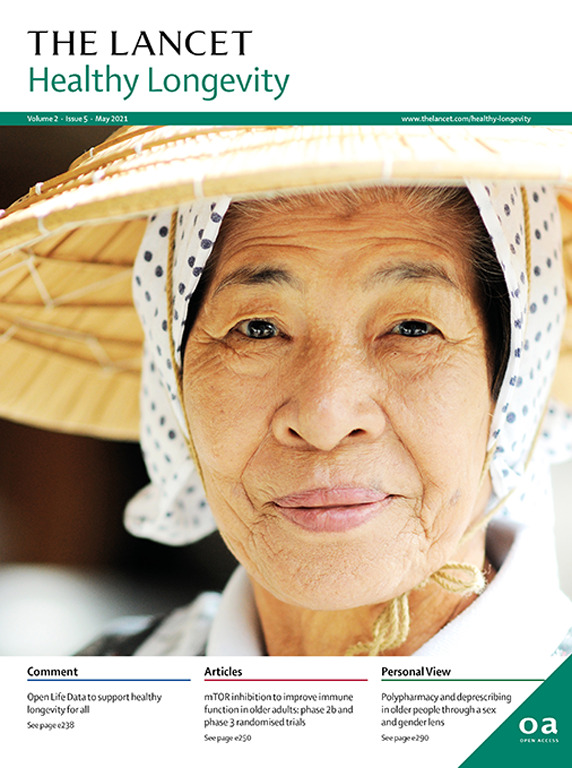Effectiveness and safety of using statin therapy for the primary prevention of cardiovascular diseases in older patients with chronic kidney disease who are hypercholesterolemic: a target trial emulation study
IF 14.6
Q1 GERIATRICS & GERONTOLOGY
引用次数: 0
Abstract
Background
There remains a scarcity of evidence on initiating statin therapy for the primary prevention of cardiovascular diseases among older adults with chronic kidney disease due to the under-representation of this population in randomised controlled trials. This study aimed to evaluate the effectiveness and safety of using statin therapy for the primary prevention of cardiovascular diseases in older adults (aged 75–84 years) and very old adults (aged ≥85 years) with chronic kidney disease.
Methods
Using territory-wide public electronic health records in Hong Kong, patients older than 60 years with chronic kidney disease and with hyperlipidaemia (defined as elevated LDL cholesterol of ≥2·6 mmol/L) were identified for inclusion in the analyses and were included on a rolling basis in each calendar month from January, 2008, to December, 2015. Patients were categorised into different age groups (ie, 60–74 years, 75–84 years, and ≥85 years) for analysis, and the 60–74 years age group was used as a benchmark group to test the validity of our emulated trial since the effect of statin therapy is well established in this age group. The framework of target trial emulation was adopted to investigate the association between statin therapy and the risk of overall cardiovascular disease incidence, specific cardiovascular disease subtypes (ie, myocardial infarction, heart failure, and stroke), and all-cause mortality, as well as major adverse events (ie, myopathies and liver dysfunction). The primary outcome was overall cardiovascular disease incidence. The hazard ratios for the outcomes were estimated by pooled logistic models in the intention-to-treat analysis and the per-protocol analysis.
Findings
711 966 person-trials from 96 trials were eligible for inclusion in the study. 19 423 unique individuals with chronic kidney disease aged 60–74 years, 22 565 unique individuals with chronic kidney disease aged 75–84 years, and 8811 unique individuals with chronic kidney disease aged 85 years and older were identified for inclusion in the analyses. In patients aged 75–84 years, a significant risk reduction was observed for overall cardiovascular disease incidence in both the intention-to-treat analysis (hazard ratio [HR] 0·94 [95% CI 0·89–0·99]) and in the per-protocol analysis (0·86 [0·80–0·92]) and for all-cause mortality (0·87 [0·82–0·91] in the intention-to-treat analysis and 0·78 [0·72–0·84] in the per-protocol analysis). This risk reduction was also observed among patients aged 85 years and older for cardiovascular diseases (HR 0·88 [0·79–0·99] in the intention-to-treat analysis and 0·81 [0·71–0·92] in the per-protocol analysis), and for all-cause mortality (0·89 [0·81–0·98] in the intention-to-treat analysis and 0·80 [0·71–0·91] in the per-protocol analysis). Substantial risk reduction for myocardial infarction, heart failure, and stroke were also observed across all age groups. No significantly increased risk of myopathies or liver dysfunction was observed in any of the age groups.
Interpretation
Statin therapy is beneficial for hypercholesterolemic older patients with chronic kidney disease aged 75 years and older regarding the primary prevention against cardiovascular diseases and all-cause mortality, without posing an increased risk of major adverse events. The benefits and safety persist in those aged 85 years and older.
Funding
National Natural Science Foundation of China Excellent Young Scientists Fund (Hong Kong and Macau).
他汀类药物用于老年慢性肾病合并高胆固醇血症患者心血管疾病一级预防的有效性和安全性:一项目标试验模拟研究
背景:由于在随机对照试验中该人群的代表性不足,在老年慢性肾病患者中启动他汀类药物治疗初级预防心血管疾病的证据仍然缺乏。本研究旨在评估他汀类药物用于慢性肾病老年人(75-84岁)和高龄老年人(≥85岁)心血管疾病一级预防的有效性和安全性。方法:利用全港公共电子健康档案,在2008年1月至2015年12月的每个日历月以滚动方式纳入分析,确定60岁以上慢性肾脏疾病和高脂血症患者(定义为LDL胆固醇升高≥2.6 mmol/L)。患者被分为不同的年龄组(即60-74岁,75-84岁和≥85岁)进行分析,并以60-74岁年龄组作为基准组来测试我们模拟试验的有效性,因为他汀类药物治疗在该年龄组的效果已经很好地确立。采用目标试验模拟的框架来研究他汀类药物治疗与总体心血管疾病发病率、特定心血管疾病亚型(如心肌梗死、心力衰竭和卒中)、全因死亡率以及主要不良事件(如肌病和肝功能障碍)的风险之间的关系。主要终点是总体心血管疾病发病率。结果的风险比通过意向治疗分析和每个方案分析中的合并逻辑模型估计。结果:来自96项试验的711,966人试验符合纳入研究的条件。19 423例60-74岁慢性肾病患者、22 565例75-84岁慢性肾病患者和8811例85岁及以上慢性肾病患者被纳入分析。在75-84岁的患者中,在意向治疗分析中观察到总体心血管疾病发病率(危险比[HR] 0.94 [95% CI 0.89 - 0.99])和方案分析中观察到全因死亡率(意向治疗分析中观察到风险比[HR] 0.86[0.80 - 0.92])和全因死亡率(意向治疗分析中观察到风险比[HR] 0.87[0.82 - 0.91],在方案分析中观察到风险比[0.78[0.72 - 0.84])均显著降低。在85岁及以上的心血管疾病患者中也观察到这种风险降低(意向治疗分析的HR为0.88[0.79 - 0.99],按方案分析的HR为0.81[0.71 - 0.92]),全因死亡率(意向治疗分析的HR为0.89[0.81 - 0.98],按方案分析的HR为0.80[0.71 - 0.91])。在所有年龄组中,心肌梗死、心力衰竭和中风的风险也显著降低。在任何年龄组中均未观察到肌病或肝功能障碍的风险显著增加。解释:他汀类药物治疗对75岁及以上的老年高胆固醇血症慢性肾病患者在心血管疾病和全因死亡率的一级预防方面是有益的,而不会增加主要不良事件的风险。对于85岁及以上的老年人,其益处和安全性依然存在。资助项目:国家自然科学基金、中国杰出青年科学家基金(港澳区)。
本文章由计算机程序翻译,如有差异,请以英文原文为准。
求助全文
约1分钟内获得全文
求助全文
来源期刊

Lancet Healthy Longevity
GERIATRICS & GERONTOLOGY-
CiteScore
16.30
自引率
2.30%
发文量
192
审稿时长
12 weeks
期刊介绍:
The Lancet Healthy Longevity, a gold open-access journal, focuses on clinically-relevant longevity and healthy aging research. It covers early-stage clinical research on aging mechanisms, epidemiological studies, and societal research on changing populations. The journal includes clinical trials across disciplines, particularly in gerontology and age-specific clinical guidelines. In line with the Lancet family tradition, it advocates for the rights of all to healthy lives, emphasizing original research likely to impact clinical practice or thinking. Clinical and policy reviews also contribute to shaping the discourse in this rapidly growing discipline.
 求助内容:
求助内容: 应助结果提醒方式:
应助结果提醒方式:


